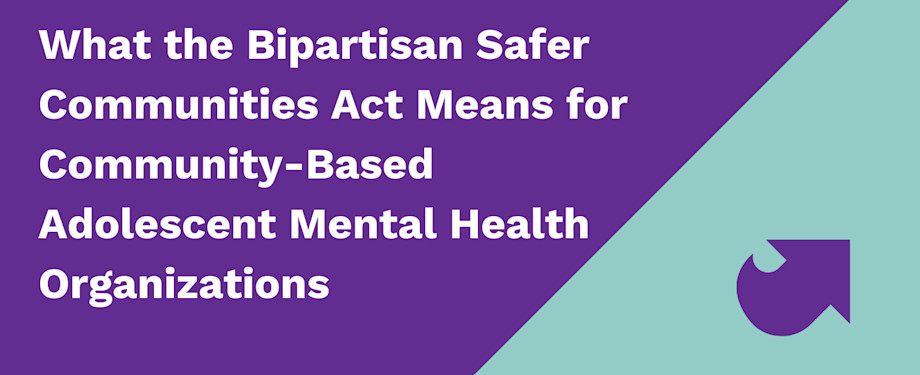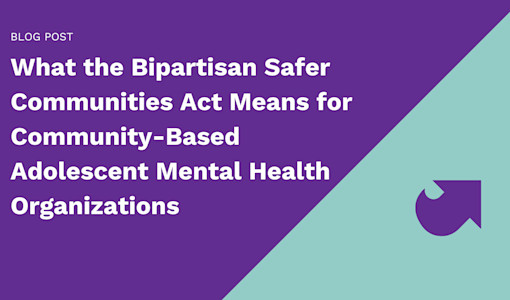

July 13, 2022 | Articles
What the Bipartisan Safer Communities Act Means for Community-Based Adolescent Mental Health Organizations
Submission by Emily Erhard, Upswing Graduate Intern
The Bipartisan Safer Communities Act
On June 25th, President Biden signed the Bipartisan Safer Communities Act into law. This law is the first major federal legislation to address firearm safety in decades and includes key provisions to bolster crisis intervention, violence prevention, and mental health services. Notable mental health funding authorized by this legislation includes:
- $500 million to help schools hire and retain mental health professionals
- $500 million to build a pipeline of school mental health professionals
- $250 million to expand the Community Mental Health Services Block Grant
- $250 million for community-based violence prevention initiatives
- $240 million to support school-based mental health programs
- $150 million to implement the 988 Suicide and Crisis Lifeline
- $40 million to improve trauma treatment services for youth and families
- $40 million to expand the Certified Community Behavioral Health Clinic (CCBHC) Demonstration Program
Why Address Youth Mental Health, School Support, and Gun Safety Together?
In the wake of the school shooting in Uvalde, Texas, the nation has turned renewed attention to the impact of gun violence on children, adolescents, and families. Gun violence and access to firearms has an immense impact on youth mental health and wellbeing. In 2020, gun violence was the leading cause of death among children and teens. Experienced and witnessed gun violence has significant and lasting impacts on youth mental health. The severity of these traumas are amplified when they take place in community spaces where families should feel safest like schools. Youth who experience school shootings exhibit higher rates of post-traumatic stress, suicide, depression, substance use, and anxiety. Academic challenges are also reflected in student experiences including drops in enrollment, declines in average test scores, increased absenteeism, and lower rates of high school graduation.
Firearms also play a significant role in suicide risk among youth. Youth suicide by firearm has reached its highest rate in 20 years and 60% of all firearm deaths are suicides. 90% of suicide attempts with a firearm are fatal, while only 4% of those not involving a firearm are fatal.
To combat the youth mental health crisis, it is critical that we increase efforts to prevent community violence and trauma, reduce suicide risk, bolster in-school supports, and increase access to community mental health services. This legislation is an important step towards achieving these aims.
Access to Federal Funding for Community-Based Organizations Is Limited
While this legislation broadly increases funding for youth mental health, these federal funding increases rarely trickle down to community-based organizations.
We know that community-based organizations serve as important touchpoints for youth mental health care, particularly for diverse youth. LGBTQ+ youth and youth of color feel more comfortable receiving mental health services in familiar community-based organizations rather than larger clinics where they are more likely to experience barriers in stigma, lack of insurance, and insufficient knowledge in navigating complex health systems.
Yet, federal and state funding opportunities often require organizations to already have significant and sustainable infrastructure to be eligible for funding. For example, in order to become a Certified Community Behavioral Health Clinic (CCBHC) and qualify for some of the increased funding in this the Bipartisan Safer Communities Act, an organization must fulfill numerous standards across six criteria areas:
- Staffing (e.g., must employ a Psychiatrist as Medical Director)
- Service Accessibility and Availability (e.g., must provide 24/7 mobile crisis stabilization services)
- Care Coordination (e.g., must have resources to support care coordination with local emergency departments)
- Scope of Services (e.g., must have dedicated services for veterans)
- Quality and Other Reporting (e.g., must prepare annual federal and state reports supported by routine data collection in an electronic record)
- Organizational Authority (e.g., must receive additional accreditation from national organizations based on state-specific requirements)
These criteria areas for CCBHCs reflect the complex federal funding eligibility criteria that we see across many programs administered by the Department of Education, the Department of Health & Human Services, and the Substance Use and Mental Health Services Administration (SAMHSA). These eligibility requirements are often unattainable for smaller, community-based organizations that already rely on stitching together resources from philanthropy and their own income streams in order to meet their communities’ needs. This is especially true in light of the severe behavioral health workforce shortage and exponentially increasing demand for services which leaves smaller organizations increasingly overstretched while striving to provide care to those most in need.
Even when organizations do meet eligibility criteria, federal grant applications are often lengthy, complex processes with heavy documentation requirements that are challenging for community-based organizations with small staffs to manage—especially when additional state and local requirements complicate the application, awarding, and reporting process.
How Community-Based Organizations Might Benefit
Community-based organizations like our Upswing partners demonstrate strong implementation of accessible, equitable, and culturally responsive organizational and care practices. They are care champions who flexibly respond to their communities’ needs in order to make the largest impact possible for those who need it the most. To make sure we are supporting their frontline efforts in the mental health crisis, we must ensure that they have a seat at the table in deciding how resources under federal, state, and local mental health care programs are distributed.
One avenue for community providers to provide input in funding decisions is through State Behavioral Health Planning Councils. Each state is required to have a planning council that reviews state plans and implementation reports for use of federal mental health funding and provides recommended modifications. These planning councils monitor, review, and evaluate the allocation and adequacy of mental health services in the state at least one each year.
By joining state planning councils or similar local planning and advisory councils, community mental health providers can bring their lived and professional experience serving youth and families on the ground into the decision-making process. As we learn more about the implementation of federal mental health funding increases, we hope to see more avenues for community providers and organizations to participate in planning and access these resources. Creating a sustainable, accessible, and equitable mental health care ecosystem to address the mental health crisis starts from listening to the providers closes to the work in their communities.


